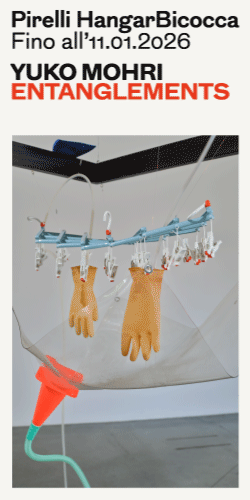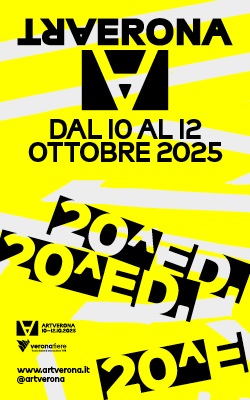[nemus_slider id=”54190″]
—
English text below
Testo di Giulia Brivio
Queste le prime tracce della mostra personale di Em’kal Eyongakpa, inaugurata venerdì 18 marzo alla Apalazzo Gallery. A poche ore dall’apertura, l’artista è partito per il Camerun, dove è nato, per concludere un nuovo progetto di sound recordings nella foresta, lontano da centri abitati e da qualsiasi connessione analogica o virtuale con il resto del mondo. Impossibile contattarlo, ma ci si può immergere negli ambienti che ha creato nell’antico palazzo nel centro di Brescia.
—
Sono spazi che si muovono secondo traiettorie improvvisate eppure precise. Spazi oltre lo spazio, che non necessitano di coordinate. Spazi del presente e del passato, che affiorando dall’oscurità diventano reali. Impossibile incorniciare e immobilizzare la pratica artistica di Em’kal Eyongakpa, è necessario lasciarla fluire nella dissolvenza e nell’unione dei diversi medium. Video, scultura, fotografia, installazione, performance, senza gli argini imposti dalla tecnica diventano altro, si fondono assecondando il ritmo della realtà e allo stesso tempo dell’irrealtà, mescolano dimensioni contingenti e illusorie, continuando a generare nuovi e antichi spazi, forse anche futuri. Il metallo si trasforma in una pioggia rovesciata di stelle e in molli fili di luce rotanti. Boom! Esplosioni che invadono con violenza il cielo. Cadono dietro ai palazzi e vengono risucchiate dal buio. Boom! Fuochi d’artificio che illuminano a intermittenza l’ultima notte dell’anno. “Amsterdam is burning!” Eyongakpa crea ecosistemi di bagliori e di ombre, di rumori e di musica, paesaggi sonori naturali e urbani, in dialogo continuo. Sono ambienti pulsanti capaci di amplificare lo spazio, con un boato spalancano le finestre facendo entrare un tornado di sconosciute percezioni e una brezza delicata di disorientamento.
Lo spazio è un luogo? È un luogo indefinibile? È una fase transitoria? È percepibile?
Filtri, livelli, trasparenze si appoggiano sulle immagini di un mondo che l’artista registra attraverso gli occhi, la macchina fotografica e la trasposizione dei propri sogni. L’interesse non è nella rilettura del dato reale, ma nel danzare con lo sguardo e la mente tra gli spazi esplorati, ripensandone le connessioni e costruendo spazi sociali dove ridefinire le relazioni in un processo costante di negoziazione tra realtà e surrealtà. Il suono intreccia tessuti culturalmente densi di difficoltà e bellezze, in un moto perpetuo che è quello dell’universo, ma anche quello del viaggio. Da diversi anni l’artista si sposta tra Africa, Europa e America, accompagnato da scenari sempre diversi che scorrono rapidi fuori dal finestrino del treno, della barca, dell’aereo.
La musica e le registrazioni ambientali creano spazi profondi, incantati, sfuggenti, che possono rimandare agli ecosistemi sonori di Luc Ferrari, dove però alla drammatizzazione del racconto sonoro si sostituiscono echi di narrazioni autobiografiche, mescolati alle voci della propria terra e di quella che lo sta ospitando: le grida dei venditori del mercato di Douala, le bolle d’aria che gorgheggiano nel fiume che scorre non lontano da dove è nato, lo scricchiolio dei grilli e il fruscio delle onde sulle coste del Mediterraneo. Le immagini e le composizioni sonore si muovono come riflessi sull’acqua, sott’acqua, quelle acque accompagnatrici della diaspora. Sono anche le acque denunciate da Amiri Baraka “At the bottom of the Atlantic ocean there’s a railroad made of Human Bones…”, che oggi scorrono nel Mar Mediterraneo o le acque senza nemici di “Water No Get Enemy” di Fela Kuti.
La natura è sempre presente, a volte impercettibile, altre volte esplicita: forme che sbocciano, rami che si piegano, foglie che tremano sull’acqua, il cosmo che si curva, i pianeti che ruotano. Una cosmologia terrena che si riflette nello spazio, o viceversa. Un tempo scandito dalle fasi lunari. ??Full Moons Later. Un tempo che si ripete, rituale. Dis sonic rituals. Una connessione naturale di Eyongakpa con i nonni sciamani. Impressioni autobiografiche appaiono sotto forma di morbidi e gonfi riflessi, da una inconsueta radiografia del calco della propria schiena, illuminato e traslucido, e in autoritratti in dissolvenza, scattati nel luogo di incontro con le proprie radici, Naked Roots.
Le immagini e i suoni volano nello spazio come lettere scritte d’impulso, senza essere rilette, dirette e oneste, immediate e visionarie. In questo momento di sospensione, girando in un vortice, si intravvede un nuovo alfabeto segnico, Letters from Etokobarek (Europa), che ha il ritmo di lingue antiche, segni che si ripetono come in un rituale, onde che si infrangono accarezzando e insieme colpendo aspramente la terra. La poesia si adagia su ogni lavoro di Eyongakpa, si fonde con gli altri medium e si sovrappone agli elementi che accelerano e rallentano nello spazio, li sfuma con le tinte delicate di altre realtà e li ridisegna con il proprio vocabolario. L’artista sembra aver trovato il linguaggio in grado di preservare l’antica ricchezza e autenticità della lingua dei propri antenati, corrotta dall’imposizione di due lingue europee in Camerun. E la voce dell’artista recita possibili narrazioni. Gli spazi che si aprono davanti, sotto, sopra di noi, sono in flusso continuo, cambiano direzione, ruotano come se non esistesse la forza di gravità. In un processo non processato si sviluppano fuori da ogni schema.
La ricerca artistica di Eyongakpa è estemporanea, contingente, oserei dire Fluxus in un’accezione contemporanea, per il flusso creativo che si espande negli ambienti, dalla strada alla galleria d’arte; per la transitorietà di progetti e di visioni; per la diffusione e dispersione transcontinentale degli esponenti del gruppo, sempre in viaggio e connessi da una rete epistolare; per la forza rivoluzionaria capace di scardinare e mai omologarsi al sistema dell’arte. Partendo proprio dalla musica, unirono le altre discipline artistiche, riscrissero le regole per infrangerle, non si definirono mai, promossero il disorientamento e allo stesso tempo furono capaci di aderire alla realtà quotidiana, di registrarne le vibrazioni, gli enigmi e i silenzi, per un pubblico anche di persone comuni. Un approccio estremamente vivo, che fa respirare l’arte e la muove secondo ritmi inediti.
Em’kal Eyongakpa
Beats/bits of(f) space(s) – Letters from Etokobarek – Chapter 1:i
18 marzo – 14 maggio 2016
Apalazzo Gallery, Brescia

Em’kal Eyongakpa
Beats/bits of(f) space(s) – Letters from Etokobarek – Chapter 1:i
Text by Giulia Brivio
What space? What spaces? What rhythm? What beat?
Spaces that move in line with improvised yet precise trajectories. Spaces beyond space that have no need for coordinates. Spaces of the present and the past, emerging from the darkness and becoming real.
It is impossible to frame or pin down the artistic practice of Em’kal Eyongakpa; rather it must be left to flow in the blurring and uniting of various media. Video, sculpture, photography, installation, performance: without the limits imposed by technique they become something else entirely; they melt together, aping the rhythm of reality and at the same time of unreality; they mix contingent and illusory dimensions, continuing to generate old and new spaces, and perhaps even future ones. Metal is transformed into an upside-down rain of stars and in soft threads of rotating light. Boom! Explosions that violently invade the sky. They fall behind the buildings and are sucked up by the darkness. Boom! Fireworks that intermittently light up the last night of the year. “Amsterdam is burning!” Eyongakpa creates ecosystems of glows and shades, of noises and music, natural and urban soundscapes, in an ongoing dialogue. These are pulsating environments capable of amplifying space; with a roar they throw windows open, letting in a tornado of unknown perceptions and a delicate zephyr of disorientation.
Is space a place? Is it an undefinable place? Is it a transitory phase? Is it perceptible?
Filters, layers and transparencies lean on the images of a world that the artist documents through his eyes, his camera and the transposition of his own dreams. The interest lies not in the reinterpretation of the real datum, but in dancing with the gaze and the mind among the spaces explored, rethinking its connections and constructing social spaces in which to redefine the relations in a constant process of negotiation between reality and unreality. The sound intertwines various narratives, culturally dense with hardship and beauty, in a perpetual movement which is that of the universe but also of the journey. For several years, the artist has shifted between Africa, Europe and America, accompanied by ever-changing scenarios that flow past the window of the train, boat and plane.
The music and the field recordings create profound, enchanted and fleeting spaces, which may reference the sound ecosystems of Luc Ferrari, yet they are ones in which the dramatization of the sound story is replaced by autobiographical narratives, blended with the voices of his own land and the one that hosts him: the cries of sellers in the marketplace of Douala, the air bubbles that gurgle in the river that passes not far from where he was born, the chirping of the crickets and the roar of the waves along the coasts of the Mediterranean. The images and the sound compositions move like reflections on the water, underwater, those waters that accompany the diaspora. These are also the waters described by Amiri Baraka in “At the bottom of the Atlantic ocean there’s a railroad made of Human Bones…”, which today run through the Mediterranean Sea, or those of “Water No Get Enemy” by Fela Kuti.
Nature is always present, at times unperceivable, at other times explicit: shapes blossoming, branches bending, leaves quivering on the water’s surface, the curve of the cosmos, the rotation of the planets. A land-based cosmology reflected in space, or vice versa. Time punctuated by moon cycles. ??Full Moons Later. A time that repeats, ritualistically. Dis sonic rituals. Eyongakpa’s natural connection with his shamans grandparents. Autobiographical impressions appear in the form of soft, swollen reflections, from an unusual radiography of a cast of his own back, illuminated and translucent, to faded self-portraits, shot in the place where he meets his own roots: Naked Roots.
The images and sounds fly through space like letters written on the spur of the moment, without being reread, direct and honest, immediate and visionary. In this moment of suspension, whirling through a vortex, we can make out a new semiotic alphabet, Letters from Etokobarek (Europe), which has the rhythm of ancient languages, signs that are repeated like in a ritual, breaking waves, both stroking and striking the ground fiercely and softly. Poetry settles on every work by Eyongakpa, blending with the other media, and overlaying the elements that accelerate or slow down in space; it blurs them with the delicate shades of other realities and redraws them with its own vocabulary. The artist seems to have found a language capable of conserving the ancient wealth and authenticity of the tongue of his ancestors, corrupted by the imposition of two European languages in Cameroon. And the voice of the artist recites potential narratives.
What space? What spaces? What rhythm? What beat?
The spaces that open up in front of us, below us and above us are in constant flow, changing direction, spinning as if there were no force of gravity. In an unprocessed process, they develop outside any possible scheme. Eyongakpa’s artistic research is extemporary, contingent, and I might even say ‘Fluxus’ in a contemporary acceptation of the term, by virtue of the creative flow which spreads through the environments, from the street to the art galleries; of the transitory nature of his projects and visions; of the transcontinental diffusion and dispersion of the group’s exponents, forever travelling and linked to an epistolary network, and by virtue of the revolutionary force, capable of taking apart and not conforming to the art system. Starting from music, they united the other artistic disciplines, rewrote the rules that they were to break, and without ever defining themselves; they promoted disorientation and at the same time proved themselves capable of adhering to everyday reality, recording its vibrations, enigmas and silences for an audience also made up of common people. An extremely lively approach, one which lets art breathe and makes it move to original rhythms.












